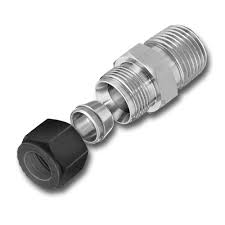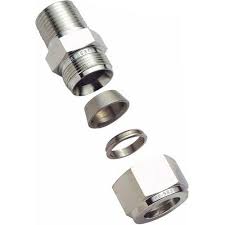In the realm of hydraulic systems, reliable connections are paramount to ensure smooth operations and prevent costly leaks. Hydraulic compression fittings serve as the unsung heroes in creating secure and leak-free connections.
In this article, we will delve into the world of hydraulic compression fittings, exploring their components, advantages, types, installation procedures, and applications. So, let’s embark on a journey of understanding the crucial role of hydraulic compression fittings in ensuring the integrity of hydraulic systems.
Understanding Hydraulic Compression Fittings
Hydraulic compression fittings are specialized connectors that join hydraulic components together, such as pipes, tubes, or hoses. These fittings create a tight and reliable connection by compressing a ferrule onto the pipe or tube, ensuring a leak-free seal.
The three main components of hydraulic compression fittings are the ferrule, nut, and body. The ferrule, typically made of soft metal or plastic, acts as the sealing element, while the nut secures the connection by compressing the ferrule onto the pipe or tube. The body provides the housing for these components, facilitating the connection.
Advantages of Hydraulic Compression Fittings
➢ Secure and Leak-Free Connections:
One of the primary advantages of hydraulic compression fittings is their ability to create secure and leak-free connections. Leaks in hydraulic systems can lead to reduced performance, equipment damage, and even hazardous situations. Compression fittings address this concern by providing a tight seal that prevents leakage.
The ferrule, when compressed properly, forms a tight grip on the pipe or tube, ensuring a reliable connection that can withstand high pressures and vibrations commonly found in hydraulic systems.
➢ Easy Installation and Disassembly:
Another notable advantage of hydraulic compression fittings is their ease of installation and disassembly. Unlike other types of fittings that require complex assembly techniques or specialized tools, compression fittings offer a simple and straightforward installation process. The components are easy to handle, and the connection can be made quickly, saving time and effort.
Additionally, when maintenance or repairs are required, compression fittings can be easily disassembled without damaging the pipe or tube, allowing for convenient access and efficient system maintenance.
Types of Hydraulic Compression Fittings
Single Ferrule Compression Fittings
Single ferrule compression fittings, also known as “single bite” fittings, utilize a single ferrule to seal the connection. These fittings are suitable for a wide range of applications and offer easy installation. The ferrule bites into the pipe or tube when the nut is tightened, creating a secure and reliable connection.
Double Ferrule Compression Fittings
Double ferrule compression fittings employ two ferrules to achieve a tight seal. The first ferrule ensures the primary seal, while the second ferrule acts as a backup, providing additional sealing and resistance to vibration. Double ferrule fittings are commonly used in high-pressure systems and critical applications where reliability is paramount.
Materials Used in Hydraulic Compression Fittings
Hydraulic compression fittings are available in various materials, each offering specific characteristics to suit different applications. Some common materials used for compression fittings include stainless steel, brass, and carbon steel. Stainless steel fittings provide excellent corrosion resistance and durability, making them suitable for demanding environments. Brass fittings offer good corrosion resistance and are often preferred for plumbing applications. Carbon steel fittings are robust and durable, making them suitable for high-pressure and heavy-duty applications.
Proper Installation of Hydraulic Compression Fittings
To ensure the optimal performance and reliability of hydraulic compression fittings, proper installation is crucial.
The steps are as follows:
Preparation and Inspection
Before installation, it is important to prepare the components and inspect them for any defects or damage. Ensure that the pipe or tube is clean and free from debris or contaminants. Check the dimensions and integrity of the components to ensure compatibility and proper fitment.
Step-by-Step Installation Process
To install a hydraulic compression fitting, follow these steps:
1. Slide the Ferrule and Nut onto the Tube
Begin by sliding the ferrule and nut onto the pipe or tube, ensuring that the ferrule is placed in the correct orientation. Ensure that the ferrule is seated properly, with its smooth side facing the nut.
2. Tighten the Nut to Create a Secure Connection
Using a wrench or appropriate tool, tighten the nut onto the fitting body. Apply firm, but not excessive, pressure to compress the ferrule evenly onto the pipe or tube. Avoid over tightening, as it may damage the ferrule or cause leaks. Once the nut is tightened, the connection should be secure and ready for use.
Maintenance and Troubleshooting of Hydraulic Compression Fittings
Regular inspection and maintenance are essential to ensure the continued performance and reliability of hydraulic compression fittings.
Here are some considerations:
➢ Regular inspection and maintenance:
Regularly inspect the fittings for any signs of damage, leaks, or wears. Look for visible cracks, corrosion, or deformities that may compromise the integrity of the connection. Check for leaks by visually inspecting the fittings while the system is in operation. Address any issues promptly to prevent further damage or system failure.
➢ Troubleshooting common issues:
If you encounter leaks or fitting failures, there are several troubleshooting steps you can take. First, check the tightness of the nut to ensure it is properly secured. If leaks persist, consider replacing the ferrule or the entire fitting if necessary. Overtightening or undertightening can also lead to problems, so ensure that the nut is tightened to the manufacturer’s recommended torque specifications.
Applications of Hydraulic Compression Fittings
➢ Plumbing and Fluid Transfer Systems
Hydraulic compression fittings find extensive use in plumbing and fluid transfer systems. They are commonly employed in residential and commercial plumbing installations, providing reliable connections for water supply lines, gas lines, and other fluid conveyance applications. The simplicity of installation and the leak-free performance make compression fittings a preferred choice in these applications.
➢ Automotive and Aerospace Industries
The automotive and aerospace industries rely on hydraulic systems for various functions, including braking, steering, and landing gear operation. Compression fittings play a vital role in these industries, providing secure connections for hydraulic lines and ensuring the safe and efficient operation of critical systems. Their ability to withstand high pressures and vibrations makes them well-suited for the demanding environments encountered in these sectors.
Safety Considerations for Hydraulic Compression Fittings
When working with hydraulic compression fittings, it is important to prioritize safety. Here are some key considerations:
➢ Proper handling and installation practices:
Ensure that you have the appropriate tools and follow the manufacturer’s instructions for installation. Use caution when handling hydraulic components, as they may be under pressure or contain hazardous fluids. Adhere to proper safety procedures, such as wearing protective gloves and eyewear, to minimize the risk of injuries.
➢ Regular system inspections and maintenance:
Implement a regular inspection and maintenance schedule to identify and address potential safety hazards. This includes checking for leaks, loose connections, or signs of deterioration. By taking a proactive approach to system maintenance, you can prevent accidents, equipment failures, and costly downtime.
Final Thought
Hydraulic compression fittings play a crucial role in creating secure and leak-free connections in hydraulic systems. Their advantages, including reliable sealing, easy installation, and compatibility with various applications, make them an indispensable component in numerous industries.
By understanding the different types of compression fittings, selecting appropriate materials, following proper installation procedures, and prioritizing safety, hydraulic systems can operate efficiently and reliably.
So, whether it’s in plumbing, automotive, aerospace, or other industries, the significance of hydraulic compression fittings cannot be understated in maintaining the integrity and performance of hydraulic systems.
Post time: Jun-23-2023



